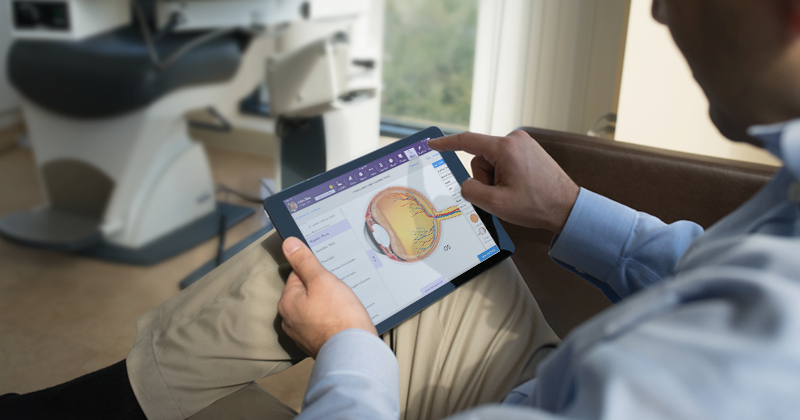Starting Your Own Ophthalmology Practice

Some ophthalmologists enjoy the security of employment within a large hospital group or healthcare network. Others prefer the personal touch of a small practice or clinic. Starting your own ophthalmology practice, however, may strike your perfect balance of career growth and personal independence.
When planning your new ophthalmology private practice, you’ll have more than clinical operations to consider. You’ll decide how much to invest, whether to go solo or team up with partners, how to handle the business affairs, and what systems to adopt for electronic health records (EHR), practice management (PM), and patient engagement platforms.
If you’ve ever wondered about starting a private practice in ophthalmology, keep reading for some key considerations.
How much does it cost to start an ophthalmology practice?
Don’t be intimidated. You survived medical school and residency. You have what it takes to start an ophthalmology practice. Just do your homework. As you may have guessed already, office space and capital equipment will be two major factors in the equation.
![]() -Let’s start with your new office. Shop for space that’s already laid out well for a medical practice, thus minimizing tenant improvements. If a space needs extensive changes, it can take tens of thousands of dollars to reconfigure. An empty shell, even more to build out. To give yourself some breathing room, ask landlords about creative ways they may structure a lease.
-Let’s start with your new office. Shop for space that’s already laid out well for a medical practice, thus minimizing tenant improvements. If a space needs extensive changes, it can take tens of thousands of dollars to reconfigure. An empty shell, even more to build out. To give yourself some breathing room, ask landlords about creative ways they may structure a lease.
The other major capital cost is equipment, probably into the six figures. The final number will be determined by your specialty and questions like new versus used and on-site server versus cloud-based software. These days, some cloud-based EHR, PM and billing systems obviate the expenses of buying, maintaining and replacing servers in your offices.
Solo vs. Partner Practice
Partnership and sole proprietorship each have their advantages.
Advantages of a Partnership
Marketing and decision support: By teaming up, you deploy more brainpower to market the practice and hire the best staff, and you won’t have to make every decision yourself. If your partners practice in similar subspecialties, you can build a powerfully focused brand. If you work in different fields, you can attract a broader range of patients.
Sharing expenses: The biggest benefit of partnering in an ophthalmology private practice may be sharing the capital and operating costs, especially helpful for younger physicians still paying off med school.
Sharing the workload: You can achieve a better work/life balance by partnering with like-minded professionals who have similar goals and work ethics. You may share responsibilities, reduce hours spent on admin, and free up time for a personal life. If partners work in similar fields, they can see your patients when you’re not available.
Advantages of a Solo Practice
Autonomy: One reason you’re starting your own ophthalmology practice is autonomy, and a solo ophthalmology practice gives you that. You can provide care the way you judge best.
Running the business: As a solo practitioner, you call the shots. You don’t have to compromise goals, accommodate the work ethics of partners, or risk differences of opinion that can hobble a business.
Business Side of an Ophthalmology Practice
You may graduate medical school knowing all about retinas, cataracts and glaucoma, but how deep did you dive into how to start a private practice in ophthalmology — or even about the practice management of a successful business?
 Great ophthalmologists care for their patients however they can, and some practice management systems help them do that better than others — making the scheduling easy, keeping the payments transparent, enabling clear communications.
Great ophthalmologists care for their patients however they can, and some practice management systems help them do that better than others — making the scheduling easy, keeping the payments transparent, enabling clear communications.
At the same time, you can find yourself at a disadvantage when dealing with the administrators who run healthcare, such as hospital systems and insurance carriers. Their priorities may not be yours.
But you don’t need a business degree to survive and thrive, because flexible, integrated, cloud-based software systems can help you in key areas:
• Organizing the patient experience
• Hiring and managing staff
• Sharing and securing data
• Understanding practice performance
• Choosing equipment
• Billing and getting paid
With the right systems, you can focus on becoming a successful CEO of your private practice in ophthalmology. Instead of focusing on servers and software, you can focus on leadership, strategy, marketing, finance and oversight. You can set the agenda, create the culture, drive the values and build the brand you want.
Importance of an EHR System When Starting an Ophthalmology Practice
To improve efficiency, performance and patient satisfaction, true cloud-based EHR software can be accessed from anywhere and scaled easily, and you can forget about replacing EHR and PM servers and manually updating software.
 The ophthalmology-specific EHR software EMA® is a flexible, integrated, cloud-based EHR system developed by ModMed®. It can be accessed by desktop, iPad or smartphone, from your exam room, office, home, hotel, airplane seat — basically, wherever you are. Your patients can use its engagement tools — patient portal, self-scheduling, kiosk — for scheduling and signing in, and you can use EMA while facing your patients.
The ophthalmology-specific EHR software EMA® is a flexible, integrated, cloud-based EHR system developed by ModMed®. It can be accessed by desktop, iPad or smartphone, from your exam room, office, home, hotel, airplane seat — basically, wherever you are. Your patients can use its engagement tools — patient portal, self-scheduling, kiosk — for scheduling and signing in, and you can use EMA while facing your patients.
Built by ophthalmologists for ophthalmology private practices, it learns your most common complaints, diagnoses, and treatment protocols, and it suggests ICD-10 codes, which are built in. It contains ophthalmology-specific content — patient counseling, surgical planning, procedure and interpretation reports, operative and post-op evaluations — which you can customize. Subspecialty expertise is included for cataract and refractive, glaucoma, retina, oculoplastics, and pediatrics.
EMA is designed so that when the exam is done, so is the documentation, and the counseling handouts, prescriptions, consult letters and invoices are queued up for you to send out. The system even captures data at the point of care, based on your documentation, to build and report your estimated composite MIPS score, using an easy-to-read scorecard. Such efficiency can be critical to your success, especially in a solo ophthalmology practice.
Ophthalmology Practice Management and Billing Software
When starting your own ophthalmology practice, another critical system is practice management and billing. It schedules appointments, checks patients in and out, generates quotes and invoices, manages claims and collections, analyzes business metrics, displays reports, and files documents.
Practice Management (PM) software from ModMed also integrates fully with EMA to streamline these processes, assisting everyone in your ophthalmology practice.
Financial managers get billing workflow reports, claim-scrubbing prior to submission, automated claim submission and remittance advice, and tools to analyze rejections and denials.
Front desk staff get tools for appointments, automated insurance eligibility verification, patient balances at check-in and checkout, and follow-up details.
Medical staff get check-in alerts with patient status, real-time communications with billing staff, tools to manage fees during visits, and access to patients’ financial data.
Administrators get tools to manage the revenue cycle, performance reports with key metrics, and client support.
The bottom line is visibility and control, and ModMed’s PM software has received Capterra’s Best Ease of Use award, based on the opinions of individual end users as expressed in published reviews.
Starting an Ophthalmology Practice: Conclusion
So what do you think? Is starting an ophthalmology practice something that sounds possible? Once you understand the initial investment required, advantages of partnering and going solo, how to manage the business, and what systems to choose for electronic health records and practice management, you may be ready for the career growth and personal independence that can result from starting your own ophthalmology practice.
This blog is intended for informational purposes only and does not constitute legal or medical advice. Please consult with your legal counsel and other qualified advisors to ensure compliance with applicable laws, regulations and standards.




